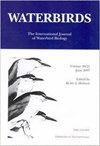得克萨斯州中海岸国家野生动物保护区的黑铁占据率和可探测性
IF 0.6
4区 生物学
Q3 ORNITHOLOGY
引用次数: 0
摘要
摘要。联邦濒危物种东部黑铁(Laterallus jamaicensis jamaicensis)很难被探测到,现有的调查方法可能无法对其进行很好的监测。本项目的目标是探索得克萨斯州海湾沿岸黑铁甲的栖息地和可探测性,并确定每天进行调查的最佳月份和时间。从 2014 年 3 月 5 日至 5 月 31 日,我们在圣伯纳德野生动物保护区和布拉佐里亚野生动物保护区的 90 个点进行了调查。我们对每个点进行了六次访问--在黎明、黄昏和夜晚各访问两次,并使用回放调查来诱发黑铁轨的发声。我们测量了每个点的栖息地特征,包括植被高度、枯落物深度、水深、茎干密度、树冠高度、物种组成以及自上次规定燃烧以来的时间。平均占用率为 0.75 ± 0.25,高度在 0 到 10 厘米之间的茎的平均数量达到或超过 6 根时占用率最高。平均冠层顶高(即枯死植被层之上的冠层顶高)、冠层底高(即土壤之上的冠层顶高)以及 20 至 30 厘米之间的茎干数量也会影响占用率。探测概率平均为 0.11 ± 0.03,夜间最高,并随着春季的到来而增加。由于发现概率较低,需要反复进行呼叫广播调查才能发现该物种。这项研究的结果对于确定德克萨斯州的调查时机非常重要,我们建议今后对这一稀有物种的调查如果在日落后约 2.5 小时搜索鸟类,将取得最大成功。本文章由计算机程序翻译,如有差异,请以英文原文为准。
Black Rail Occupancy and Detectability in the Texas Mid-Coast National Wildlife Refuge
Abstract. The federally Threatened Eastern Black Rail (Laterallus jamaicensis jamaicensis) is difficult to detect and may not be well monitored by existing survey methods. The goals of this project were to explore occupancy and detectability of Black Rails along the Texas Gulf Coast and to determine the best months and time of day to conduct surveys. We conducted surveys at 90 points in San Bernard NWR and Brazoria NWR from 5 March through 31 May 2014. We visited each point six times—twice each at dawn, dusk, and night and used playback surveys to elicit Black Rail vocalizations. We measured habitat characteristics for each point, including the vegetation height, litter depth, water depth, stem density, canopy height, species composition, and time since last prescribed burn. Occupancy rates averaged 0.75 ± 0.25 and was greatest where the average number of stems between 0 and 10 cm in height was six or greater. The average canopy ceiling height (i.e., height of canopy ceiling above layer of dead vegetation), canopy floor height (i.e., height of canopy ceiling above soil), and number of stems between 20 and 30 cm also affected occupancy. Detection probability averaged 0.11 ± 0.03 and was highest at night, increasing over the course of the spring. Due to the low probability of detection, repeated call-broadcast surveys will be required to detect this species. The results of this study are important for determining the timing of surveys in Texas, and we suggest that future surveys for this rare species will have the greatest success if they search for birds approximately 2.5 hours after sunset.
求助全文
通过发布文献求助,成功后即可免费获取论文全文。
去求助
来源期刊

Waterbirds
生物-鸟类学
CiteScore
1.30
自引率
0.00%
发文量
0
审稿时长
6-12 weeks
期刊介绍:
Waterbirds is an international scientific journal of the Waterbird Society. The journal is published four times a year (March, June, September and December) and specializes in the biology, abundance, ecology, management and conservation of all waterbird species living in marine, estuarine and freshwater habitats. Waterbirds welcomes submission of scientific articles and notes containing the results of original studies worldwide, unsolicited critical commentary and reviews of appropriate topics.
 求助内容:
求助内容: 应助结果提醒方式:
应助结果提醒方式:


